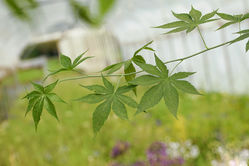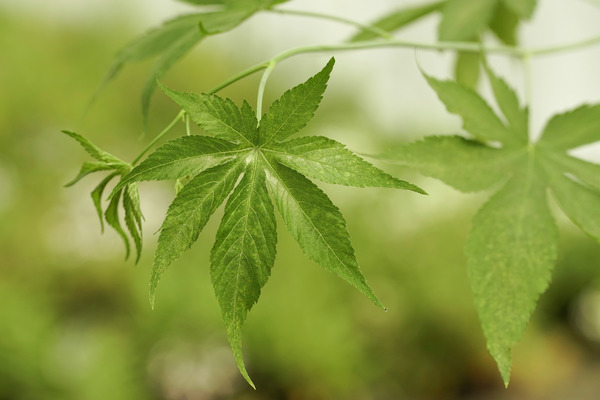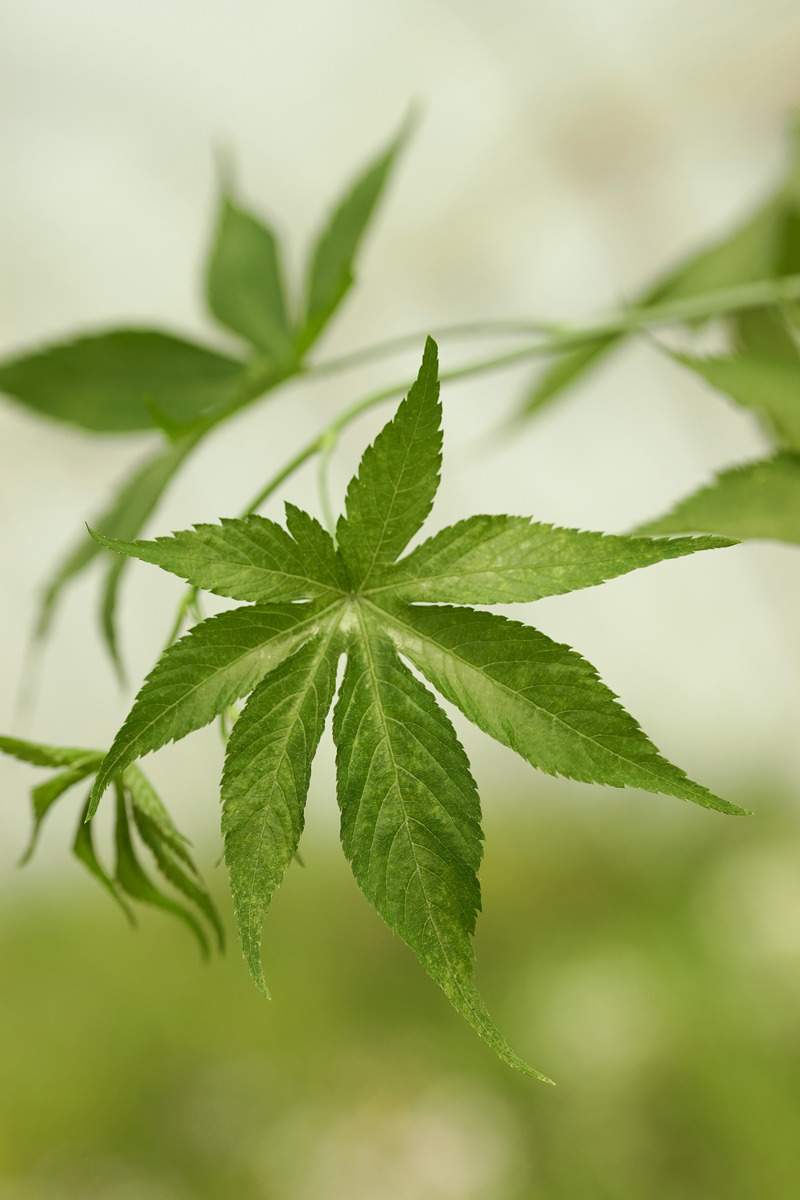 Basically, it almost sounds like a pious Christmas wish from a plant lover: to have a perennial and hardy plant that can be cultivated sustainably both in the garden and in pots, and whose leaves contain an ingredient that gives the leaves an incredible sweetening power. We can fulfil this wish with the Sweetleaf® raspberry – a perennial and hardy, Stevia-like plant that is ideal for a temperate, winter cold climate.
Basically, it almost sounds like a pious Christmas wish from a plant lover: to have a perennial and hardy plant that can be cultivated sustainably both in the garden and in pots, and whose leaves contain an ingredient that gives the leaves an incredible sweetening power. We can fulfil this wish with the Sweetleaf® raspberry – a perennial and hardy, Stevia-like plant that is ideal for a temperate, winter cold climate.
What is the Sweetleaf® raspberry?
But what is the Sweetleaf® raspberry? It is the Rubus species 'Rubus chingii var. suavissimus', sometimes just called Rubus chingii or Rubus suavissimus. Botanists will probably never agree on this. The common name is Chinese sweet tea plant. We have given our selection of Rubus chingii a descriptive name, so that “it says what's in it”: we call it the Sweetleaf® raspberry or even simpler and sweeter: the Sweetleaf®.

Picture: the typical leaf shape of the Sweetleaf® raspberry
The advantages of the Sweetleaf® raspberry
These are the advantages of this new as well as unusual Rubus variety, whose leaves are the actual fruit and are harvested:
- Leaves with an extreme sweetness (the molecule underlying the sweetening effect is 200x sweeter than sugar)
- An unlimited supplier of sweeteners
- Sweet leaves can be preserved by drying
- Strong growth
- Perennial and hardy
- Suitable for growing in containers
Origin of the Sweetleaf® raspberry
The Sweetleaf® raspberry originates from China, where it is native to the southern provinces of Guizhou, Guang Dong and Guangxi.
How does the Sweetleaf® raspberry grow?
The Sweetleaf® raspberry is a strong-growing and deciduous shrub. The freshly growing shoots have enormous vigour and an upright growth habit, reaching a height of about 250 cm. Due to the enormous growth vigour, the fresh shoots are very tolerant to pruning and they will sprout again below the cutting from each leaf axil in a really short time. The fresh, green shoots are heavily armed with thorns, but this is not particularly negative due to the rather extensive use – since only the leaves are of interest.
The leaves have a striking, five-lobed shape, which at first glance strongly resembles hemp. At the Lubera® nursery, a large container plant stood by the entrance all summer; hardly a visitor passed by without looking curiously and wondering if Lubera also wants to get on the hemp bandwagon. No, we are not interested in CBD or THC; we are interested in sugar substitutes.

Picture: the resemblance to a hemp leaf cannot be denied
Does the Sweetleaf® raspberry also bear fruit?
Unfortunately, we have not yet been able to observe any blossoms on the plants in our viewing garden and, accordingly, we have not yet been able to taste any fruits. They are supposed to be rather small and orange-red. Now, the loss of yield can have various reasons, but two causes are probably the most likely. On the one hand, it may be that the flowering plants in the leaf axillary buds freeze in the course of the winter (without the plant being otherwise damaged). This phenomenon can also be observed with the large-fruited kiwi, among others. On the other hand, it may also be due to the domestication or selection by humans, which obviously focused on the leaf benefit and not on the fruit. Mildly overwintered trial plants will provide answers to this question in the coming years.
Even without fruit yield, the Sweetleaf® raspberry seems to be a typical representative of the Rubus family: the canes have a biennial growth cycle, in which they die back or just languish. From the base and from the roots, new shoots emerge every year, which can reach up to 250 cm already in the first year.
There are also native populations of Rubus chingii in Japan that have the same phytosanitary characteristics as the Chinese origins, but whose leaves have no sweetness.
What it's really all about: the sweetness of the Sweetleaf® raspberry
The incredible sweetness of the Sweetleaf® raspberry lies in its leaves and the secondary plant compounds they contain from the group of kaurane glycosides known as 'rubusosides'. The kaurane glycosides also include, for example, the 'steviosides' from the plant Stevia rebaudiana, which received a great deal of attention a few years ago as a calorie-free sugar substitute. And these two glycosides are very comparable in their chemical structure and therefore also have a similar to identical sweetening power. The chemical molecule 'rubusoside' in its pure form is about 200 times sweeter than commercially refined sugar from sugar beets, with the emphasis on the following: 'the molecule in its pure form'. Even the fresh leaves have tremendous sweetness. If you chew on a piece of leaf, it tastes rather neutral-green at first, before an extreme, broad, dull sweetness overwhelms your sense of taste.
Health arguments and 'traditional Chinese medicine' (TCM)
In addition to the leaves in the form of tea, the dried fruits of the Sweetleaf® raspberry have been used in 'traditional Chinese medicine' (TCM) since ancient times (so there must be fruits somehow?). In addition to the glycoside 'rubusoside', the leaves and the fruits contain a variety of other bioactive ingredients that have or are supposed to have a positive effect on people's health. Even if this plant presentation should not end in a medicinal-chemical treatise, some possible mechanisms of action should be mentioned: for example, some of the bioactive ingredients should have an antioxidant, anticancerogenic, kidney-promoting or antibacterial effect.
How do I use the Sweetleaf® raspberry?
We will focus on the main property of this super exciting plant: its sugar-like sweetness. And don't worry; you don't need a pharmacy degree to use the Sweetleaf® raspberry in your garden or nursery production. We recommend a very simple use: tear or cut the fresh, green leaves harvested from the bush into pieces and then scald them with hot, but no longer boiling water. In the process, the sweet-acting ingredients are released from the leaf and absorbed by the water. The amount of leaves used is purely a matter of taste. Some like it a little sweeter (more leaves); others like it not quite so sweet (fewer leaves). In addition, you can also rub the leaves in the palms of your hands before over-brewing, so the leaf structure is destroyed and the sweetening substances can more easily escape from the cells.

Picture: the fresh and also the dried leaves of the Sweetleaf® raspberry will be used
As already described, the Sweetleaf® raspberry is a deciduous shrub. If you do not want to do without the sweetening leaves in the winter, you should build up a winter supply towards the end of the summer (end of August/beginning of September) by drying the harvested leaves. The dried leaves can then be stored like any commercial tea. It is best to keep them in a not too warm, dry and light-proof place. The dried leaves are a good way to bridge the winter until the Sweetleaf® raspberry begins its impetuous growth again in the spring.
The Sweetleaf® raspberry in your own garden
The Sweetleaf® raspberry can be grown quite easily in your own garden, only the soil or the location should not be too wet. The Sweetleaf® does not differ from normal raspberries. Due to the strong growth and the thorny canes, however, a location in a little-used corner of the garden is recommended. The Sweetleaf® raspberry is also quite sensible as a property boundary if you also want to treat your neighbour to a little sugar. With its ornamental hemp-like foliage, the Sweetleaf® raspberry can also be integrated into a free-growing flowering hedge. In terms of care, it is important to note that the two-year-old canes die back over the summer and should then be removed completely in autumn at the latest. This is where the close relationship between raspberries and blackberries becomes apparent.
In addition, it is also possible to grow the Sweetleaf® raspberry in a container. Due to the strong growth, however, the container should be appropriately large, but at least 25 L. It is also possible to limit the height of the one-year-old canes, since the Sweetleaf® raspberry is very tolerant to pruning and side shoots form below the cut after a short time, which can of course also be harvested again. If the canes are cut at a height of 180 - 200 cm, the side shoots form a kind of canopy, which results in a very beautiful and in any case eye-catching habit.
Growing the Sweetleaf® raspberry in a container is possible without any problems thanks to its good winter hardiness. Despite its origin in southern China, we have not yet had any winter plant failures in our variety screening at temperatures as low as minus 16°C and without protection. Also, the deciduous characteristic probably contributes its part to the winter hardiness, since there is no evaporation surface in the winter. And if some canes do not survive the winter, the fresh shoots from the base compensate for this loss in the spring.
Production and marketing of the Sweetleaf® raspberry
Sweetleaf® raspberry young plants will be available for purchase from Lubera Edibles® starting in spring 2021 – albeit in limited quantities. Due to the production build-up, it is also worthwhile to reserve larger quantities now for spring 2022. We offer the Sweetleaf® young plants in 60-cell trays. In terms of production, Sweetleaf® raspberry young plants are comparable to the young plants of any other raspberry variety and can be used in the same way when producing finished products. To further emphasise the value of this particular plant, the sales size should not be too small. It is recommended to use a 3 L pot rather than a 1.5 L pot.
Do you not yet have any Sweetleaf® raspberry young plants? Then order your young plants for this year or already for spring 2022!
